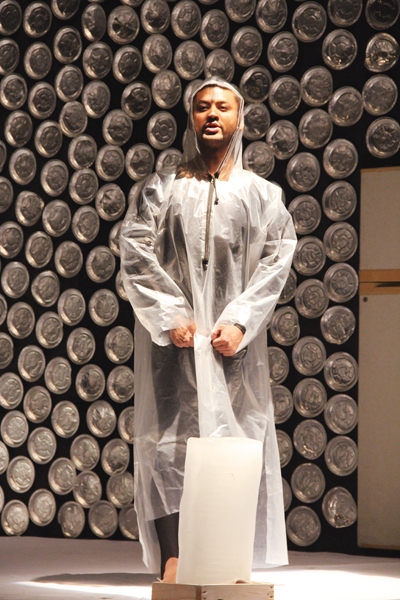
KARACHI:
The Princess and the Garden saw a very unusual setting for Napa’s stage. It was decorated with shiny silver plates as a girl dressed up in a transparent, plastic gown sat on a chair. She was sitting on stage-right and staring into a Handicam. As she zoomed the camera onto her eyes, the image was being projected on a screen that had been carved out on the centre of the set. The irritating, yet piercing sound loop reminded one of distorted radio signals, failing to connect and quite simply implied communication failure.
Time to connect the dots: the girl in the gown, the zooming in of the camera as if she is about to say something, the shiny silver backdrop, all of it coupled with the distorted audio; the first impression that came to mind was of an inter-galactic space setting. But was that intended? Not really.
Bhimal Zubedi, the director of The Princess and the Garden managed to create an unusual atmosphere, something that the Pakistani audience is not used to, at least not in theatre. Regaredless, if you have read the play, you’ll be confused because up till now, nothing really signifies that a Tagore short play about Buddhism and poverty is being performed. The symbolism is fresh, unorthodox and experimental, but a little out of place, and half-baked. This performance is also the first technical rehearsal of these young and ambitious artists from Nepal. Having said that, the major reason that the audience was not able to grasp the narrative, was the fact that the play was being performed in Nepali.

The background, props and costumes in this play were unlike any other seen before in Karachi. PHOTOS: AYESHA MIR/EXPRESS
Malini, the short play by Rabindranath Tagore is the story of a young Brahmin princess Malini, who has been brought up under the guidance of Buddhist monks. One day, she publicly announces her acceptance of the Buddhist way of life, after which the whole kingdom is struck with surprise and shock. The much agitated Brahmin majority in the Kingdom demands the immediate banishment of Malini. Upon realising the suffering of her people as a result of the confession, she herself announces her own banishment. As a result, a debate starts between Kemankar, who started a rebellion against Malini, and Supriya, his best friend who supports her, and believes that the truth is being sacrificed because of the majority.
Theatre Village, the troupe that was performing the play, has clearly put more stress on the ideological clash between Kemankar and Supriya, and not as much on Malini’s romance with poverty and Buddhism. They used body movements to show the divide between Kemankar and Supriya, and since it was an ideological war, they were throwing balls with multi-coloured blinking lights at each other, instead of arrows or bullets.
After the play, Zubedi spoke to The Express Tribune and shared what he wanted to communicate with this very experimental take on Malini.
“This is a modern adaptation of the play, and has been set post the royal massacre time in Nepal, it is obviously not very direct, but subtle,” Zubedi told The Express Tribune.
“The different aesthetic tools that I have used are to create a counter between the forces of peace and hatred. That is the reason why the space that you look at is so shiny and beautiful, but the audio that you hear is irritating. It’s the clash that needs to be addressed” he said.
Shedding some light on the use of visual metaphors, Zubedi explained the details of the set, some of which couldn’t be seen clearly from the audience’s perspective. Such as the refrigerators being used as exit doors on stage which he believes added another layer to the larger themes of poverty and hunger that the play revolves around. The balls with multi-coloured blinking lights were used both as an ideological exchange between the two forces, and also to glorify the concept of an enlightened death.
“Since the character dies for the sake of enlightenment, I followed this incident with a shower of blinking balls so that the audience doesn’t take death as a negative experience. It should rather be celebrated” he shared.
On the other hand, Karma, one of the main actors of the play, thinks that the play is essentially a Buddhist narrative but it should be looked at from a philosophical perspective.
“More than looking at it from religious way, I’d prefer looking at Malini from a philosophical perspective” said Karma, who is an active member of the Nepali theater and film industry. “This play by Tagore has nothing to do with any religion, but an alternate way of life which can inspire anyone.”
He further added that the team didn’t even perform 20 per cent of what the play is actually about, but is hopeful that the play’s positive message would be understood by the very few people who have read it. “If we cut ourselves, it’s the same red blood that flows through all of our veins. Instead of looking at differences, we should be looking at common things amongst all religions, and move forward with our lives,” Karma said, stressing on the underlying message of the play.
The entire Theatre Village troupe is excited about their visit to Karachi, and as they went around seeing the city of lights, they have had their fair share of cultural shocks in Pakistan.
“What the TV shows us or the newspaper tells is a very grim picture of Pakistan, so much so that my family wasn’t allowing me to visit,” Zubedi told The Express Tribune.
“Once I came here, I was totally shocked to see the kind of hospitality we have received, and more so how serious the people of Pakistan are about cultural activities. They are fun, art-loving people like anywhere else in the world, it’s just that we didn’t know,” added Zubedi.
Published in The Express Tribune, March 11th, 2014.
Like Life & Style on Facebook, follow @ETLifeandStyle on Twitter for the latest in fashion, gossip and entertainment.






















































COMMENTS
Comments are moderated and generally will be posted if they are on-topic and not abusive.
For more information, please see our Comments FAQ